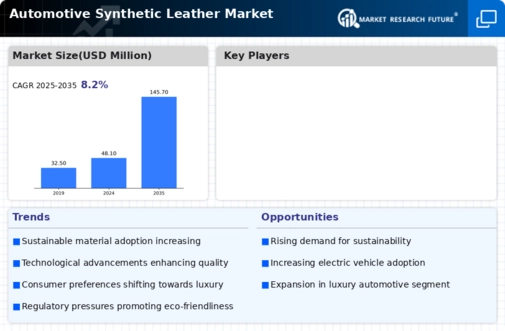Market Trends
Key Emerging Trends in the Automotive Synthetic Leather Market
The market trends of automotive synthetic leather are undergoing significant changes influenced by technological advancements, consumer preferences, and the automotive industry's increasing focus on sustainability. A notable trend in this market is the growing demand for high-quality automotive synthetic leather that closely mimics the look and feel of genuine leather. As consumers seek luxurious and aesthetically pleasing interiors in their vehicles, manufacturers are investing in advanced manufacturing techniques to produce synthetic leather with realistic textures, softness, and durability, providing a premium alternative to traditional leather upholstery.
Moreover, environmental sustainability is a key influencer in the automotive synthetic leather market. With a heightened awareness of ecological concerns, there is an increasing shift towards eco-friendly and cruelty-free materials in the automotive industry. Manufacturers are responding by developing synthetic leather made from sustainable sources, incorporating recycled materials, and utilizing environmentally friendly production processes. This trend aligns with the broader automotive industry's commitment to reducing its environmental footprint and meeting consumer expectations for sustainable and ethically sourced materials.
Customization is emerging as another significant trend in the automotive synthetic leather market. As consumers seek personalized and unique vehicle interiors, manufacturers are offering synthetic leather options with a wide range of colors, textures, and finishes. Customizable synthetic leather interiors allow automakers to cater to diverse consumer preferences, enabling a more tailored and individualized approach to automotive design.
Technological advancements are playing a crucial role in reshaping the automotive synthetic leather market. Manufacturers are incorporating innovative technologies to enhance the performance characteristics of synthetic leather, such as improved resistance to wear, UV stability, and ease of maintenance. Additionally, advancements in manufacturing processes, including 3D printing and digital embossing, contribute to the production of synthetic leather with intricate patterns and realistic textures, further enhancing its appeal in automotive interiors.
Furthermore, there is a growing trend towards the integration of smart features in automotive synthetic leather. With the rise of connected and autonomous vehicles, manufacturers are exploring the incorporation of sensor technologies and heating/cooling functionalities directly into synthetic leather surfaces. This not only enhances the comfort and convenience of vehicle interiors but also aligns with the industry's push towards smart and innovative automotive technologies.
In terms of market dynamics, competition among automotive synthetic leather manufacturers is intensifying. Companies are investing in research and development to enhance the realism, sustainability, customization, technological features, and smart functionalities of their synthetic leather products. Meeting automotive industry standards for durability, safety, and environmental impact, as well as staying attuned to evolving consumer preferences, are critical factors for success in this competitive market. As the automotive industry continues to embrace synthetic leather as a premium interior material, the market is expected to witness sustained growth and further innovation.




Leave a Comment